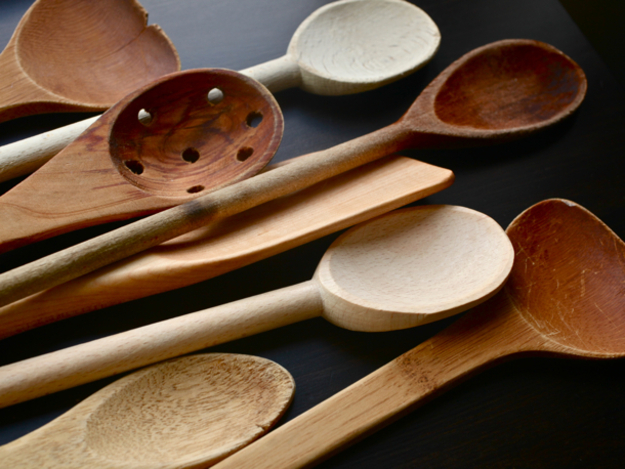Keeping your knife blade sharp, regardless of whether it’s a pocket knife or a specialized whittling knife, is a critical point in success and safety. An obvious guide to whittle the right way , but needs to be stated, is that the sharper your knife is, the easier it will be to whittle. You’ll quickly realize how dull your knife is by the amount of time and how hard it is to cut the same area of wood.
To sharpen your knife, use a sharpening stone or strop. The difference – a sharpening stone, also known as a whetstone, sharpens a blade by removing metal from the blade while a strop polishes and realigns blade material. A strop is common among whittlers and is essentially a flexible piece of leather that can quickly bring a sharp edge to the blade again. In most cases, all you’ll need is a strop but in the instances when it doesn’t do the trick, use a whetstone.
WHITTLING KNIFE SAFETY
It doesn’t matter which type of whittling knife you use you’ll want to make sure you stay safe. As with any knife, one bad slip and you can have a pretty nasty cut on your hands…quite literally. No matter how much experience you have with knives or whittling, remember these few tips.
Hand protection isn’t always a favorite among experienced whittlers but is a necessity. Ever heard of the saying “a carpenter isn’t good unless their missing fingers”? Well, it’s not true. A good carpenter knows how to stay safe. A good whittler is the same.
While leather gloves can be worn when you’re whittling, they can sometimes become a burden. Thumb guards, or thumb pads, are the next option. They slip over your thumb and help prevent cuts and nicks that can happen inadvertently. They are pretty cheap, easily replaceable, and will save you many, many headaches.
Mentioned earlier, knife sharpness, is a good, all-around habit to have when handling knives of any kind, especially those you’re working with. While it may sound counter-intuitive, a sharp knife helps keep you safe. You’ll use less pressure when cutting as well as making cuts easier. Dull blades won’t cut wood as easy and can bounce off the wood and into your finger or hand.
Slow and steady wins the race, or in our case, the cut. Rushing a whittling project is like rushing a work project – you’ll have more mistakes and you may get it done but probably not the best you could do. Take your time. Remember, whittling is to pass time not to race against it.
HOW TO ACTUALLY WHITTLE WOOD
Up to this point we’ve told you how to prepare to whittle wood. Now, finally, we get to the fun part – how to whittle the right way to mark in wood. First thing to note, wood grain.
In most wood, you’ll see the wood grain and the direction it’s going. In most cases, cut with it. It will make your life easier. There are times, however, that you can’t avoid cutting against the grain. In those instances, certainly make sure your knife is sharp and take your time.
Surprisingly enough there are quite a few different types of cuts you’ll make when whittling. The most common are rough cut, pare cut, and push stroke. They all serve a different purpose as show below.
Rough cut is typically what you’ll start out with when cutting a fresh piece of wood. It is, essentially, cutting the wood with the grain away from your body. Make sure to not apply too much pressure so you don’t cut the wood deeper than intended. Cutting away from your body ensures that you won’t accidentally stab or cut yourself if the knife jumps off the wood. Even at this point you’ll want to take it slow and steady so you don’t make the wrong cut and have to start over. Remember, whittling is an art that requires patience and perseverance.
The pare cut is the favorite, and most common, cut of the whittler. It is nothing more than holding the knife in your dominant hand and the wood in the other. You’ll be making the cut towards you with the thumb of your dominant hand pressing against the wood. You will then slowly cut the wood towards you using small and shallow strokes while avoiding slicing your thumb open. This is the cut that can cause the most injuries and should be done with gloves or a thumb guard.
The push stroke is used for more intricate cuts and cuts that are difficult to achieve using the pare cut. You are essentially using the thumb of your dominant hand to push the blade of the knife through the wood. You can achieve many of the same cuts as the pare cut if you are uncomfortable using the pare cut or if the wood is being difficult and you need a different angle to cut.
WHITTLING PROJECTS AND IDEAS
So now you know how to whittle the right way but you need to know how to whittle. You could always choose to go old school and whittle what our ancestors did – walking sticks, figurines, smoking pipes, whistles, and even a ball in a cage. If you are a beginner you may want to keep it simple with whittling a ball, wooden egg, or a walking stick. Here are a few more ideas to get your brain working:
- Model boat
- Model airplane
- Animal totem
- Animal figurine
- Wood spoon
- Wood fork
- Wood knife
- Wood shovel
- Ball in a cage
- Wooden chains
- Wooden gnome
- Spiral pencil
- Bow and arrow
Regardless of what you decide to whittle, remember the most important rule: relax, take your time, and have fun. The wood isn’t going anywhere. Believe that this guide whittle the right way is superb many think that. Enjoy the time you have doing something that your ancestors were doing many years ago. It’s a blast!


